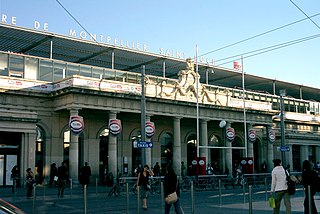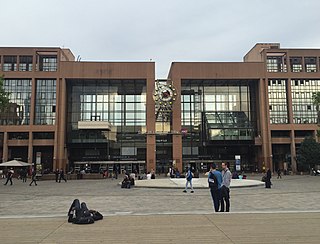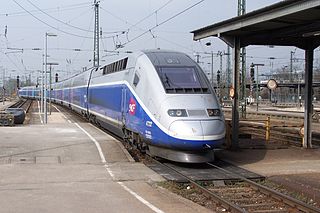Related Research Articles

The TGV is France's intercity high-speed rail service, operated by SNCF. SNCF worked on a high-speed rail network from 1966 to 1974 and presented the project to President Georges Pompidou who approved it. Originally designed as turbotrains to be powered by gas turbines, TGV prototypes evolved into electric trains with the 1973 oil crisis. In 1976 the SNCF ordered 87 high-speed trains from Alstom. Following the inaugural service between Paris and Lyon in 1981 on the LGV Sud-Est, the network, centered on Paris, has expanded to connect major cities across France and in neighbouring countries on a combination of high-speed and conventional lines. The TGV network in France carries about 110 million passengers a year.

Lyon-Perrache is a large railway station located in the Perrache district, in the 2nd arrondissement of Lyon, France. The station was opened in 1857 and is located on the Paris–Marseille railway, Lyon–Geneva railway and Moret–Lyon railway. The train services are operated by SNCF and include TGV, Intercity and local services.

The LGV Méditerranée is a 250-kilometre-long (160-mile) French high-speed rail line running between Saint-Marcel-lès-Valence, Drôme and Marseille, Bouches-du-Rhône, also featuring a connection to Nîmes, Gard.

Marne-la-Vallée – Chessy also appearing on platform displays as Marne-la-Vallée Chessy - Parcs Disneyland, is a large combined RER, and high-speed rail station in Chessy, Seine-et-Marne, France, about 30 km (19 mi) east of Paris, located on the LGV Interconnexion Est opened in 1994. The station is inside the Disneyland Paris resort, close to the entrances to the theme parks and at the entrance to Disney Village. The station opened as an extension of RER A in April 1992, in conjunction with the opening of the theme park, with The Walt Disney Company contributing €38.1 million of the €126.5 million cost. The high-speed rail part of the station opened in May 1994, two years after the RER portion of station.

Lille-Europe station is a SNCF railway station in Lille, France, on the LGV Nord high-speed railway. The station is primarily used for international Eurostar and long-distance SNCF TGV services, although some high-speed regional trains also call at the station. The station was built in 1993 to be used as a through station for trains between the UK, Belgium, and the Netherlands, as well as French TGV services, except those coming from Paris which normally terminate at Lille-Flandres. There is a 400 m (1,300 ft) walking distance between the two stations, which are also adjacent stops on the Lille Metro.

Lyon-Saint-Exupéry TGV station is a railway station near Lyon, France, directly attached to Lyon–Saint-Exupéry Airport. The station was built as an addition to the airport to serve TGV trains on the LGV Rhône-Alpes, part of the main line running from Paris Gare de Lyon to Marseille Saint-Charles. It is situated about 20 km east of Lyon city centre.

Marseille-Saint-Charles is the main railway station and intercity bus station of Marseille, France. It is the southern terminus of the Paris–Marseille railway and western terminus of the Marseille–Ventimiglia railway.

Nice-Ville station, also known as Nice-Thiers station, is the main railway station of Nice, France. It is situated on the Marseille–Ventimiglia railway and constitutes the southwestern terminus of the Nice–Breil-sur-Roya railway. Nice-Ville is served by TER, Intercités and TGV services, as well as the Gare Thiers stop on Line 1 of the Nice tramway.

Saint-Roch is the main railway station in Montpellier, France. The station was formerly known as Gare de Montpellier, but since March 2005 it has been named after Saint Roch, a native of the city who was born in the 14th century. Saint-Roch is one of the principal transport hubs of Languedoc-Roussillon, situated between the stations of Nîmes and Sète.

Gare de la Part-Dieu is the primary railway station of Lyon's Central Business District in France. It belongs to the Paris-Lyon-Marseille railway. Train services are mainly operated by SNCF with frequent TGV high-speed and TER regional services as well as Eurostar and Deutsche Bahn. Lyon's second railway station, Gare de Lyon-Perrache, is located in the south of the historical centre.

Gare de Valence TGV is a railway station in Valence, France which offers regular TGV services. The station, located in eastern Valence (Alixan), is about ten kilometres north-east from the town centre, allowing through trains to pass at full speed. With its opening in 2001, the station has considerably shortened travel times for travellers throughout eastern France.

Ilich Ramírez Sánchez, also known as Carlos the Jackal or simply Carlos, is a Venezuelan who conducted a series of assassinations and terrorist bombings from 1973 to 1985.

France has a large network of high-speed rail lines. As of June 2021, the French high-speed rail network comprises 2,800 km (1,740 mi) of tracks, making it one of the largest in Europe and the world. As of early 2023, new lines are being constructed or planned. The first French high-speed railway, the LGV Sud-Est, linking the suburbs of Paris and Lyon, opened in 1981 and was at that time the only high-speed rail line in Europe.

Ouigo is a French low-cost service range of both conventional and high-speed trains. The literal translation of Ouigo from French to English is "yes go;" the name is also a play on words with the English homonym "we go." It is composed of two different services: Ouigo Grande Vitesse, which is a brand of SNCF operating high-speed trains; and Ouigo Vitesse Classique, a brand under which Oslo, a subsidiary of SNCF, operates conventional speed trains.

The Alstom Avelia Euroduplex, more commonly known as just Euroduplex or TGV 2N2 in France, is a high-speed double-decker train manufactured by Alstom. It is primarily operated by the French national railway company SNCF, and also in operation with the Moroccan national railway company ONCF. It is the 3rd generation of the TGV Duplex.

Terrorism in France refers to the terrorist attacks that have targeted the country and its population during the 20th and 21st centuries. Terrorism, in this case is much related to the country's history, international affairs and political approach. Legislation has been set up by lawmakers to fight terrorism in France.
The Capitole train bombing was the bombing of a Le Capitole train on the Paris-Toulouse express near Limoges on 28 March 1982. The attack killed five people and injured 28 others. The bombing was claimed by a group calling itself "International Terrorist Friends of Carlos", and was later attributed to Venezuelan terrorist Carlos the Jackal. In 2011 Carlos was convicted for the bombing whilst he was already serving life imprisonment. The attack was followed with the bombing of an anti-Syrian newspaper office in Paris in April.
On 22 April 1982, a powerful car bomb detonated on Rue Marbeuf in the 8th arrondissement of Paris in France during the morning rush hour. It killed a young woman and injured 60 other people. The offices of the Lebanese newspaper Al-Watan al-Arabi appeared to be the target.
References
- ↑ "Repères méditerranéens - Attentat à la gare Saint Charles à Marseille - Ina.fr". Repères méditerranéens. Retrieved 2018-07-14.
- ↑ "Procès Carlos à Paris: examen de l'attentat du TGV Marseille-Paris". RFI (in French). 2011-11-17. Retrieved 2018-07-14.
- ↑ "Three bombs exploded minutes apart in a high-speed passenger..."
- ↑ "France convicts Carlos the Jackal". BBC News. 15 December 2011.